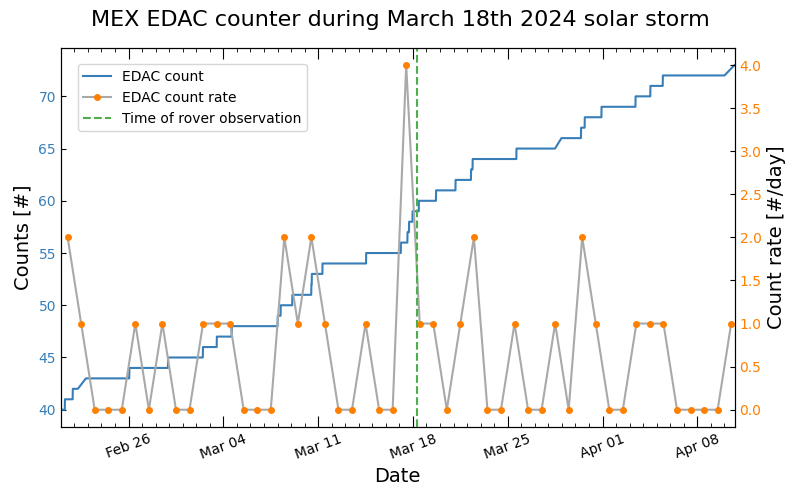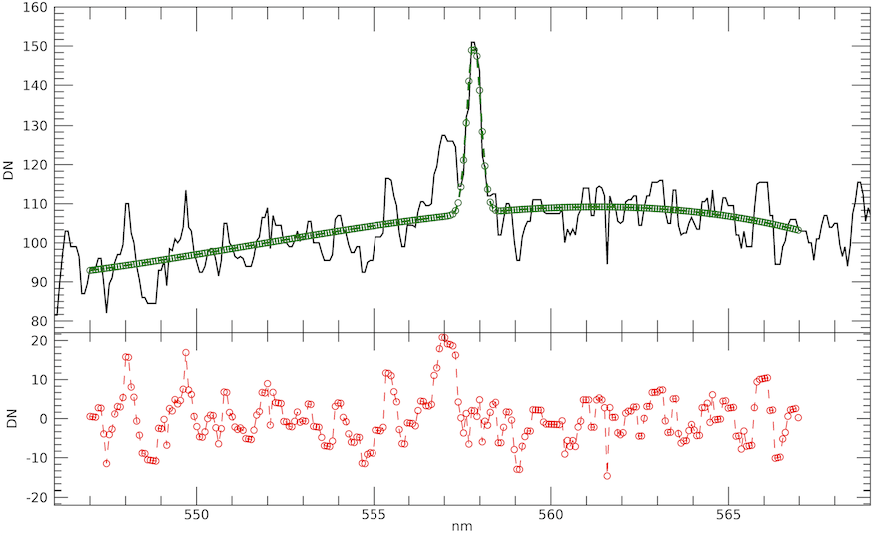First detection of visible-wavelength aurora on Mars
- 1University of Oslo, Norway (e.w.knutsen@its.uio.no)
- 2Space Science Institute, USA
- 3Jet Propulsion Laboratory, USA
- 4Norwegian University of Science and Technology, Norway
- 5Institut de recherche en astrophysique et planétologie, France
- 6Purdue University, USA
- 7Malin Space Science Systems, USA
- 8Mullard Space Science Laboratory, University College London, UK
- 9Laboratory for Atmospheric and Space Physics, USA
- 10Instituto Nacional De Técnica Aerospacial, Spain
Introduction
Auroras are hallmarks of the interaction between solar particles and the atmosphere of planets. Martian aurora was first discovered in 2005, since then, four different types have been identified: localized discreet aurora (Bertaux et al., 2005), global diffuse aurora (Schneider et al., 2015), dayside proton aurora (Deighan et al., 2018), and large-scale sinuous aurora (Lillis et al., 2022). All previous detections have been made in the UV from orbit. Here we present, from observations with the SuperCam and MastCam-Z instruments on the Mars 2020 Perseverance rover, the first detection of aurora from the Martian surface and the first detection of the green 557.7 nm atomic oxygen auroral emission on Mars. This is the same emission line that is familiar from terrestrial aurora.
Charged particles accelerated by interplanetary coronal mass ejections (ICMEs) or solar flares are referred to as solar energetic particles (SEPs) (Reames, 1999). Diffuse aurora is strongly correlated with SEP events. ICME-accelerated SEPs travel nearly radially, as opposed to flare-accelerated SEPs which follow the Parker spiral. If the solar source region is identified, ICME-accelerated SEP events at Mars, and thus diffuse aurora, can be forecasted.
The dynamic nature of rover planning and operations allows for a reactive observation strategy that takes advantage of such forecasts. We made several attempts, starting in May 2023, to react to SEP events and observe with the M2020 rover (Farley et al., 2020) instruments at times when we believed the likelihood of emission to be highest. Our fourth attempt, in March 2024, yielded the positive detection reported here.
Instruments
On the M2020, SuperCam and MastCam-Z have the best combination of sensitivity and operational flexibility for detecting diffuse aurora.
SuperCam is a multi-technique spectrometer. Its channel covering the 535-853 nm range includes an optical intensifier which can amplify weak optical signals (Wiens et al., 2021) and therefore make auroral emissions, especially the atomic oxygen forbidden transitions at 557.7 and 630 nm, detectable. Other channels lack an intensifier and therefore the UV emissions commonly seen in Mars aurora (e. g. (Schneider et al., 2015)) are not expected to be detectable.
MastCam-Z is a pair of multispectral, stereoscopic imaging cameras capable of providing broadband and narrowband color images, and direct solar images using neutral density filters. Each camera has a CCD detector with 1648×1214 pixels with a selectable field of view ranging from 6.2°×4.6° to 25.6 ×19.2° (Bell et al., 2021).
Results
On March 15th 2024, a long-lasting C4.9 flare with an accompanying ICME erupted from Active Region 13599. Mars was expected to be centered in the projected path, with ion density peaking around 04:00 UTC, March 18th.
Error Detection And Correction (EDAC) counters are cumulative housekeeping logs, registering bit-flips in spacecraft memories. EDACs are sensitive to SEP events, which manifests as jumps in the otherwise steadily increasing counter. Mars Express logged 4 times as many errors when the ICME was expected to reach Mars compared to before and after the solar storm, as indicated in Figure 1.

Figure 1: Housekeeping error log from Mars Express during the six week interval surrounding the March 18th event. The blue line shows the cumulative errors, the orange line shows the number of errors per day, and the green line indicates the time of the rover observations.
SuperCam and MastCam-Z observations were scheduled shortly after the predicted ion density peak. The SuperCam observation consisted of 2x75 spectra and began at 00:33 local mean solar time (LMST) on Sol 1094, or 06:47 UTC on March 18. Figure 2 shows an average of all spectra, after detector background subtraction, and further processing with a 3-pixel-wide median filter. Fitting a gaussian line-shape (0.452 nm FWHM) and 3rd-order polynomial continuum, we obtain 93 R for the 557.7 nm auroral emission with a 1-σ uncertainty of 13 R (Rayleigh is a photon flux, where 1 R corresponds to a column emission rate of 1010 photons per square metre per column per second). No other emission lines were observed. From preliminary radiative-transfer modeling, using an adapted version of the multiple-scattering pseudo-spherical code of Clancy et al., (2017), we estimate that the intensity would have been 1.9 kR if viewed on the limb from orbit.
MastCam-Z imaged the sky using filter position 0 in both cameras starting at 00:43 LMST. Although sky brightness was dominated by Phobos-illuminated aerosols leading to an overall yellow-orange color, after modeling and subtracting the Phobos light we found an excess green-channel signal equivalent to 100 +/- 20 R, fully consistent with the green line emission detected by SuperCam.

Figure 2: SuperCam spectra and best-fit model. Top panel: the average of 2x75 spectra shown in black, and best-fit model shown in green. Bottom panel: residual shown in red.
Summary and discussion
A green atmospheric emission was observed by the M2020 rover on March 18th 2024. The signal observed by SuperCam and MastCam-Z corresponds to an intensity of around 93 R. The observed event was likely associated with a C4.9 flare and a subsequent ICME. Considering that the particle flux increase observed in orbit coincided with the estimated arrival of the ICME, we conclude the observed diffuse aurora was mainly induced by ICME-accelerated SEPs.
This detection confirms the prediction from UV observations that emissions would also occur at optical wavelengths. This opens a new avenue for the study of space weather events at Mars. Optical instruments are simpler and cheaper than the UV instrumentation used to date. While the brightness of this event was dimmed by dust, events under better viewing conditions or heavier particle precipitation would likely be above the threshold for human vision and visible to future astronauts.
Acknowledgements
We thank Olivier Witasse for providing EDAC data, and NASA’s Mars Exploration Program for support. We acknowledge the Community Coordinated Modeling Center at Goddard Space Flight Center for the use of the DONKI tool, https://kauai.ccmc.gsfc.nasa.gov/DONKI/, and the Mars Space Weather Alert Notification system which notified us of the SEP event.
How to cite: Knutsen, E. W., McConnochie, T. H., Lemmon, M., Tamppari, L., Viet, S., Cousin, A., Wiens, R. C., Francis, R., Donaldson, C., Lasue, J., Forni, O., Patel, P., Schneider, N., Carrasco, D. T., and Palacio, V.: First detection of visible-wavelength aurora on Mars, Europlanet Science Congress 2024, Berlin, Germany, 8–13 Sep 2024, EPSC2024-767, https://doi.org/10.5194/epsc2024-767, 2024.